The Effect of PEO Treatment in a Ta-Rich Electrolyte on the Surface and Corrosion Properties of Low-Carbon Steel for Potential Use as a Biomedical Material
Abstract
:1. Introduction
2. Materials and Methods
2.1. Sample Processing
2.2. Sample Characterization
3. Results
3.1. Electric Characteristic of the PEO Treatments
3.2. Topographical Details of the PEO Coatings
3.3. Phase Composition of the PEO Coatings
3.4. Chemical and Physical Aspects of the PEO Coatings
3.5. Electrochemical Behavior of the PEO Coatings
4. Discussion
5. Conclusions
Author Contributions
Funding
Informed Consent Statement
Data Availability Statement
Conflicts of Interest
References
- Prasad, K.; Bazaka, O.; Chua, M.; Rochford, M.; Fedrick, L.; Spoor, J.; Symes, R.; Tieppo, M.; Collins, C.; Cao, A.; et al. Metallic Biomaterials: Current Challenges and Opportunities. Materials 2017, 10, 884. [Google Scholar] [CrossRef]
- Tharani Kumar, S.; Prasanna Devi, S.; Krithika, C.; Raghavan, R. Review of Metallic Biomaterials in Dental Applications. J. Pharm. Bioallied Sci. 2020, 12, S14. [Google Scholar] [CrossRef]
- Nasab, M.B.; Hassan, M.R. Metallic Biomaterials of Knee and Hip—A Review. Trends Biomater. Artif. Organs 2010, 24, 69–82. [Google Scholar]
- Jaganathan, S.K.; Supriyanto, E.; Murugesan, S.; Balaji, A.; Asokan, M.K. Biomaterials in Cardiovascular Research: Applications and Clinical Implications. Biomed. Res. Int. 2014, 2014, 459465. [Google Scholar] [CrossRef] [Green Version]
- Sarraf, M.; Rezvani Ghomi, E.; Alipour, S.; Ramakrishna, S.; Liana Sukiman, N. A State-of-the-Art Review of the Fabrication and Characteristics of Titanium and Its Alloys for Biomedical Applications. Bio-Des. Manuf. 2022, 5, 371–395. [Google Scholar] [CrossRef]
- Marulanda Cardona, D.M.; Wongsa-Ngam, J.; Jimenez, H.; Langdon, T.G. Effects on Hardness and Microstructure of AISI 1020 Low-Carbon Steel Processed by High-Pressure Torsion. J. Mater. Res. Technol. 2017, 6, 355–360. [Google Scholar] [CrossRef]
- Martínez, C.; Briones, F.; Villarroel, M.; Vera, R. Effect of Atmospheric Corrosion on the Mechanical Properties of SAE 1020 Structural Steel. Materials 2018, 11, 591. [Google Scholar] [CrossRef] [Green Version]
- Zhang, H.; Liu, D.; Zhao, L.; Wang, J.; Xie, S.; Liu, S.; Lin, P.; Zhang, X.; Chen, C. Review on Corrosion and Corrosion Scale Formation upon Unlined Cast Iron Pipes in Drinking Water Distribution Systems. J. Environ. Sci. 2022, 117, 173–189. [Google Scholar] [CrossRef]
- Yang, W.; Liu, W.; Peng, Z.; Liu, B.; Liang, J. Characterization of Plasma Electrolytic Oxidation Coating on Low Carbon Steel Prepared from Silicate Electrolyte with Al Nanoparticles. Ceram. Int. 2017, 43, 16851–16858. [Google Scholar] [CrossRef]
- Wang, Y.L.; Wang, M.; Zhou, M.; Jiang, Z.H. Characterization of Graphite Containing Ceramic Coating Prepared on Carbon Steel by Plasma Electrolytic Oxidation. Appl. Mech. Mater. 2012, 271–272, 46–49. [Google Scholar] [CrossRef]
- Wang, Y.; Jiang, Z.; Yao, Z. Formation of Titania Composite Coatings on Carbon Steel by Plasma Electrolytic Oxidation. Appl. Surf. Sci. 2010, 256, 5818–5823. [Google Scholar] [CrossRef]
- Lin, Z.; Wang, T.; Yu, X.; Sun, X.; Yang, H. Functionalization Treatment of Micro-Arc Oxidation Coatings on Magnesium Alloys: A Review. J. Alloys Compd. 2021, 879, 160453. [Google Scholar] [CrossRef]
- Clyne, T.W.; Troughton, S.C. A Review of Recent Work on Discharge Characteristics during Plasma Electrolytic Oxidation of Various Metals. Int. Mater. Rev. 2019, 64, 127–162. [Google Scholar] [CrossRef] [Green Version]
- Ma, C.; Liu, J.; Zhu, X.; Xue, W.; Yan, Z.; Cheng, D.; Fu, J.; Ma, S. Anticorrosive Non-Crystalline Coating Prepared by Plasma Electrolytic Oxidation for Ship Low Carbon Steel Pipes. Sci. Rep. 2020, 10, 15675. [Google Scholar] [CrossRef] [PubMed]
- Yang, W.; Li, Q.; Liu, W.; Liang, J.; Peng, Z.; Liu, B. Characterization and Properties of Plasma Electrolytic Oxidation Coating on Low Carbon Steel Fabricated from Aluminate Electrolyte. Vacuum 2017, 144, 207–216. [Google Scholar] [CrossRef]
- Li, H.; Kan, J.; Jiang, B.; Liu, Y.; Liu, Z. Study of the Deburring Process for Low Carbon Steel by Plasma Electrolytic Oxidation. Plasma Sci. Technol. 2016, 18, 860–864. [Google Scholar] [CrossRef]
- Wang, X.; Ning, B.; Pei, X. Tantalum and Its Derivatives in Orthopedic and Dental Implants: Osteogenesis and Antibacterial Properties. Colloids Surf. B Biointerfaces 2021, 208, 112055. [Google Scholar] [CrossRef]
- Han, Q.; Wang, C.; Chen, H.; Zhao, X.; Wang, J. Porous Tantalum and Titanium in Orthopedics: A Review. ACS Biomater. Sci. Eng. 2019, 5, 5798–5824. [Google Scholar] [CrossRef]
- Hu, W.; Xu, J.; Lu, X.; Hu, D.; Tao, H.; Munroe, P.; Xie, Z.-H. Corrosion and Wear Behaviours of a Reactive-Sputter-Deposited Ta 2 O 5 Nanoceramic Coating. Appl. Surf. Sci. 2016, 368, 177–190. [Google Scholar] [CrossRef]
- Huang, H.-L.; Tsai, M.-T.; Chang, Y.-Y.; Lin, Y.-J.; Hsu, J.-T. Fabrication of a Novel Ta(Zn)O Thin Film on Titanium by Magnetron Sputtering and Plasma Electrolytic Oxidation for Cell Biocompatibilities and Antibacterial Applications. Metals 2020, 10, 649. [Google Scholar] [CrossRef]
- Li, C.-Y.; Yu, C.; Zeng, R.-C.; Zhang, B.-C.; Cui, L.-Y.; Wan, J.; Xia, Y. In Vitro Corrosion Resistance of a Ta2O5 Nanofilm on MAO Coated Magnesium Alloy AZ31 by Atomic Layer Deposition. Bioact. Mater. 2020, 5, 34–43. [Google Scholar] [CrossRef] [PubMed]
- Zhang, S.; Zou, X.; Liu, N.; Wang, H.; Xia, C.; Liang, C. In Situ Preparation of a Novel Ta2O5/MAO Composite Coating on Magnesium for Anti-Corrosion Protection. Surf. Coat. Technol. 2022, 430, 128003. [Google Scholar] [CrossRef]
- Lukács, Z.; Kristóf, T. Determination of Kinetic Parameters from a New Quadratic Approximation of the Butler-Volmer Equation. J. Electroanal. Chem. 2022, 918, 116443. [Google Scholar] [CrossRef]
- Snizhko, L.; Yerokhin, A.; Pilkington, A.; Gurevina, N.; Misnyankin, D.; Leyland, A.; Matthews, A. Anodic Processes in Plasma Electrolytic Oxidation of Aluminium in Alkaline Solutions. Electrochim. Acta 2004, 49, 2085–2095. [Google Scholar] [CrossRef]
- Correa, D.R.N.; Rocha, L.A.; Ribeiro, A.R.; Gemini-Piperni, S.; Archanjo, B.S.; Achete, C.A.; Werckmann, J.; Afonso, C.R.M.; Shimabukuro, M.; Doi, H.; et al. Growth Mechanisms of Ca- and P-Rich MAO Films in Ti-15Zr-XMo Alloys for Osseointegrative Implants. Surf. Coat. Technol. 2018, 344, 373–382. [Google Scholar] [CrossRef] [Green Version]
- Chen, Y.; Dou, J.; Pang, Z.; Yu, H.; Chen, C.; Feng, J. Improving the Corrosion Resistance of Micro-Arc Oxidation Coated Mg–Zn–Ca Alloy. RSC Adv. 2020, 10, 8244–8254. [Google Scholar] [CrossRef]
- Wang, C.; Lu, H.; Yang, H.; Xue, B.; Jia, E.; Chai, G. The Effect of Adding Polyethylene Glycol to Electrolyte Solution on Micro-Arc Oxidation Coating on Pure Aluminum. Appl. Surf. Sci. 2022, 599, 154047. [Google Scholar] [CrossRef]
- Simchen, F.; Sieber, M.; Kopp, A.; Lampke, T. Introduction to Plasma Electrolytic Oxidation—An Overview of the Process and Applications. Coatings 2020, 10, 628. [Google Scholar] [CrossRef]
- Kim, Y.-S.; Kim, J.-G. Corrosion Behavior of Pipeline Carbon Steel under Different Iron Oxide Deposits in the District Heating System. Metals 2017, 7, 182. [Google Scholar] [CrossRef] [Green Version]
- de Alwis, C.; Perrine, K.A. In Situ PM-IRRAS at the Air/Electrolyte/Solid Interface Reveals Oxidation of Iron to Distinct Minerals. J. Phys. Chem. A 2020, 124, 6735–6744. [Google Scholar] [CrossRef]
- Hosseinpour, S.; Johnson, M. Vibrational Spectroscopy in Studies of Atmospheric Corrosion. Materials 2017, 10, 413. [Google Scholar] [CrossRef] [Green Version]
- Raacke, J.; Giza, M.; Grundmeier, G. Combination of FTIR Reflection Absorption Spectroscopy and Work Function Measurement for In-Situ Studies of Plasma Modification of Polymer and Metal Surfaces. Surf. Coat. Technol. 2005, 200, 280–283. [Google Scholar] [CrossRef]
- Bright, T.J.; Watjen, J.I.; Zhang, Z.M.; Muratore, C.; Voevodin, A.A.; Koukis, D.I.; Tanner, D.B.; Arenas, D.J. Infrared Optical Properties of Amorphous and Nanocrystalline Ta2O5 Thin Films. J. Appl. Phys. 2013, 114, 083515. [Google Scholar] [CrossRef]
- Kaga, N.; Fujimoto, H.; Morita, S.; Yamaguchi, Y.; Matsuura, T. Contact Angle and Cell Adhesion of Micro/Nano-Structured Poly(Lactic-Co-Glycolic Acid) Membranes for Dental Regenerative Therapy. Dent. J. 2021, 9, 124. [Google Scholar] [CrossRef]
- Al-Azzam, N.; Alazzam, A. Micropatterning of Cells via Adjusting Surface Wettability Using Plasma Treatment and Graphene Oxide Deposition. PLoS ONE 2022, 17, e0269914. [Google Scholar] [CrossRef]
- Sopata, M.; Karpiński, T.M.; Jakubowicz, J.; Sopata, M. Development of Tantalum with Highly Hydrophilic Surface and Antimicrobial Properties Obtained by Micro-arc Oxidation Process. J. Biomed. Mater. Res. Part B Appl. Biomater. 2021, 109, 829–840. [Google Scholar] [CrossRef] [PubMed]
- Cai, S.; Wu, C.; Yang, W.; Liang, W.; Yu, H.; Liu, L. Recent Advance in Surface Modification for Regulating Cell Adhesion and Behaviors. Nanotechnol. Rev. 2020, 9, 971–989. [Google Scholar] [CrossRef]
- Majhy, B.; Priyadarshini, P.; Sen, A.K. Effect of Surface Energy and Roughness on Cell Adhesion and Growth—Facile Surface Modification for Enhanced Cell Culture. RSC Adv. 2021, 11, 15467–15476. [Google Scholar] [CrossRef]
- Nie, X.; Cai, R.; Zhao, C.; Sun, J.; Zhang, J.; Matthews, D.T.A. Advancement of Plasma Electrolytic Oxidation towards Non-Valve Metals. Surf. Coat. Technol. 2022, 442, 128403. [Google Scholar] [CrossRef]
- Correa, D.R.N.; Grandini, C.R.; Rocha, L.A.; Proença, J.P.; Sottovia, L.; Cruz, N.C.; Rangel, E.C.; Hanawa, T. Effect of Temperature on Thermal Oxidation Behavior of Biomedical Ti-Zr-Mo Alloys. J. Alloys Compd. 2022, 905, 164202. [Google Scholar] [CrossRef]
- Yang, W.; Li, Q.; Xiao, Q.; Liang, J. Improvement of Corrosion Protective Performance of Organic Coating on Low Carbon Steel by PEO Pretreatment. Prog. Org. Coat. 2015, 89, 260–266. [Google Scholar] [CrossRef]
- Cheng, Y.; Feng, T.; Lü, J.; Hu, P.; Chen, Y. Plasma Electrolytic Oxidation Behavior and Corrosion Resistance of Brass in Aluminate Electrolyte Containing NaH2PO4 or Na2SiO3. Trans. Nonferrous Met. Soc. China 2022, 32, 3985–3997. [Google Scholar] [CrossRef]
- Wang, Y.; Jiang, Z.; Yao, Z.; Tang, H. Microstructure and Corrosion Resistance of Ceramic Coating on Carbon Steel Prepared by Plasma Electrolytic Oxidation. Surf. Coat. Technol. 2010, 204, 1685–1688. [Google Scholar] [CrossRef]
- Sangaiya, P.; Jayaprakash, R. A Review on Iron Oxide Nanoparticles and Their Biomedical Applications. J. Supercond. Nov. Magn. 2018, 31, 3397–3413. [Google Scholar] [CrossRef]
- Tan, Y.; Liu, X.; Ma, L.; Li, X.; Liao, Q. The Effect of Hematite on the Corrosion Behavior of Copper in Saturated Red Soil Solutions. J. Mater. Eng. Perform. 2020, 29, 2324–2334. [Google Scholar] [CrossRef]
- Hoseini, A.; Yarmand, B.; Kolahi, A. Inhibitory Effects of Hematite Nanoparticles on Corrosion Protection Function of TiO2 Coating Prepared by Plasma Electrolytic Oxidation. Surf. Coat. Technol. 2021, 409, 126938. [Google Scholar] [CrossRef]
- Ahlström, J.; Tidblad, J.; Tang, L.; Sederholm, B.; Leijonmarck, S. Electrochemical Properties of Oxide Scale on Steel Exposed in Saturated Calcium Hydroxide Solutions with or without Chlorides. Int. J. Corros. 2018, 2018, 5623504. [Google Scholar] [CrossRef]
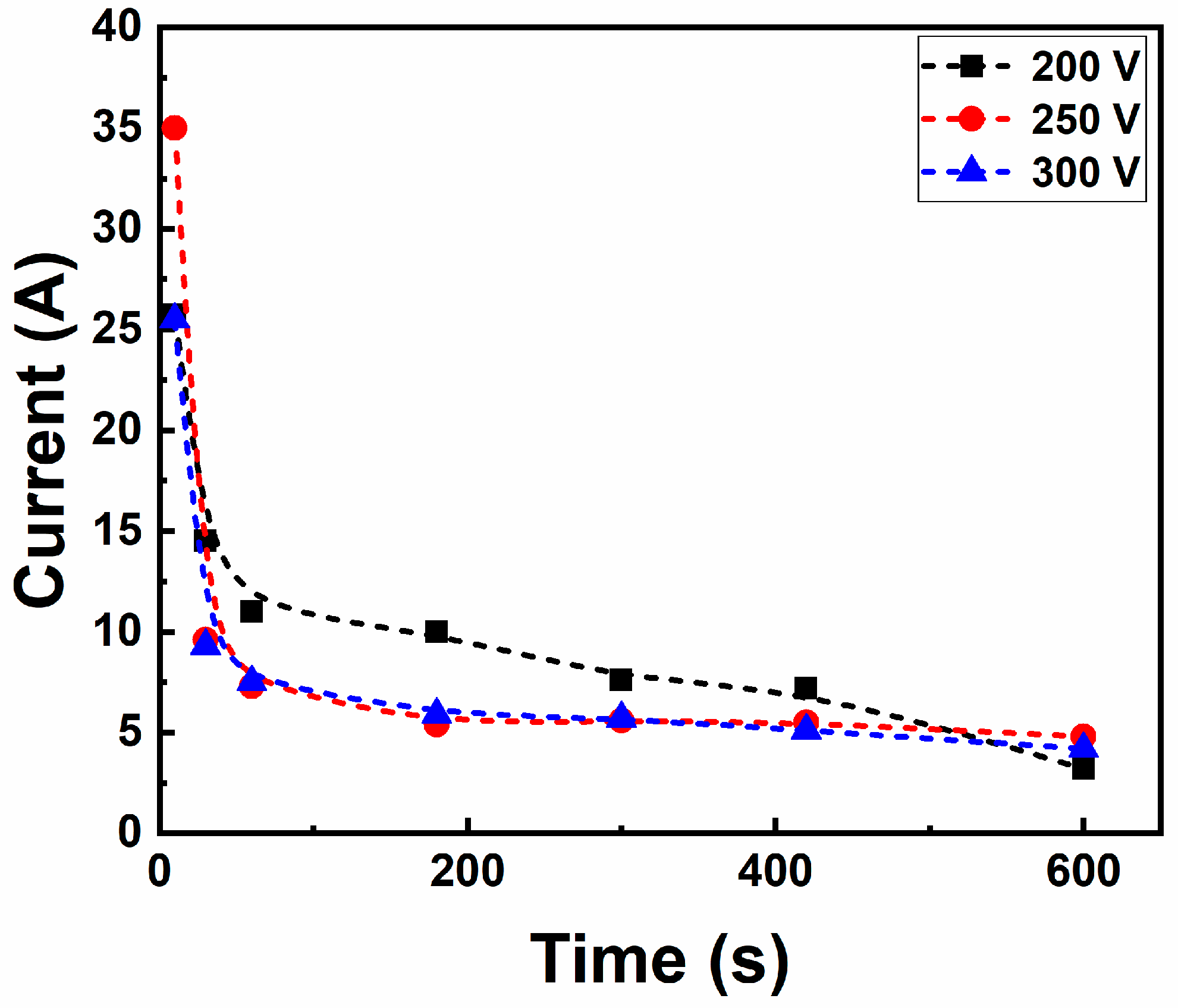

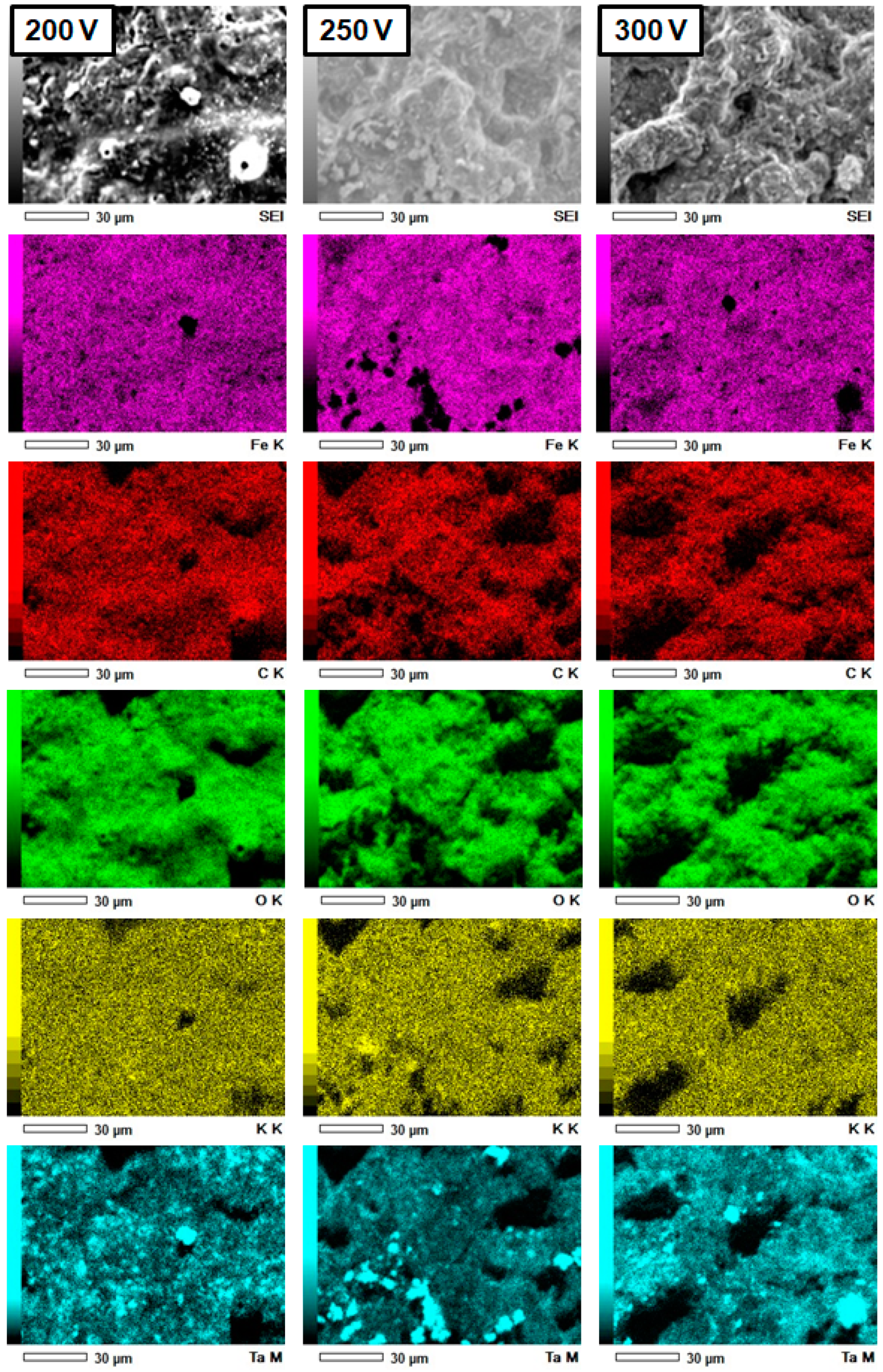
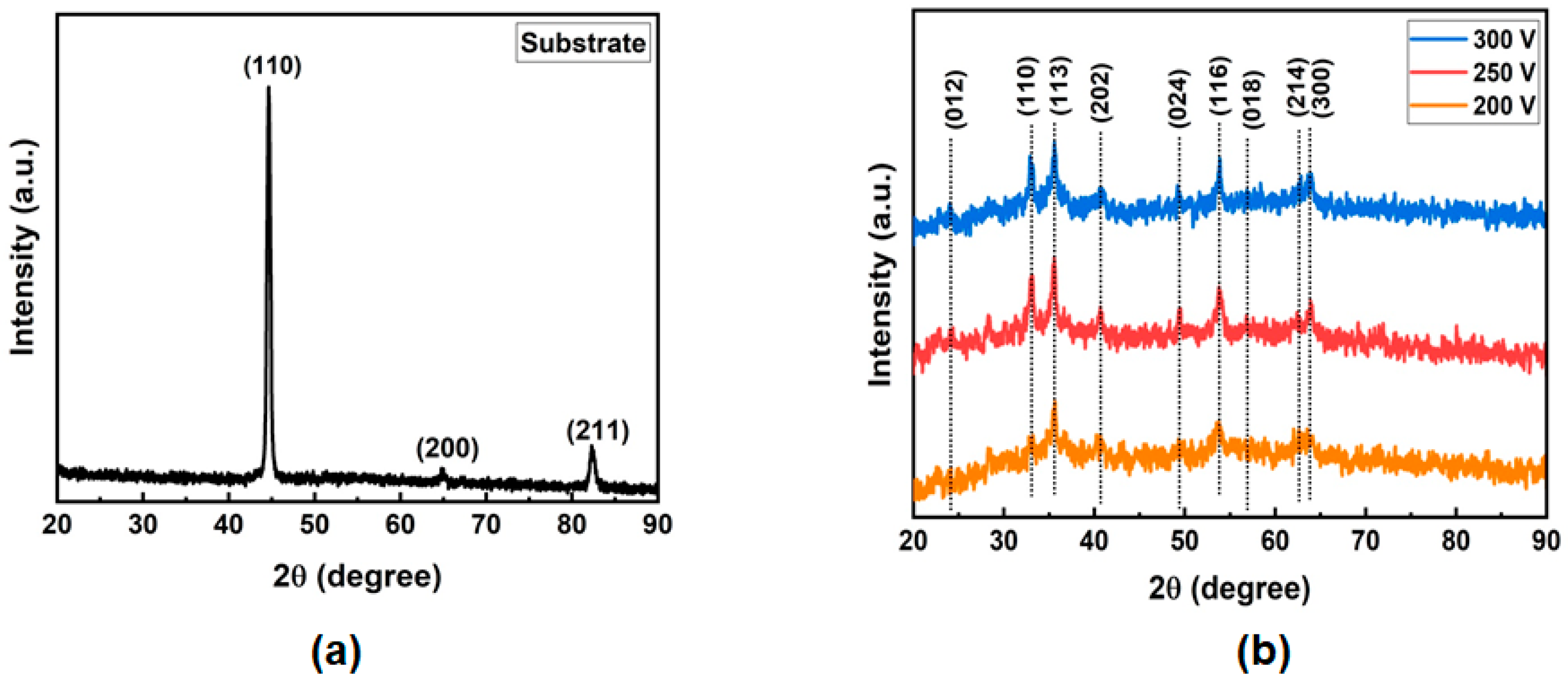
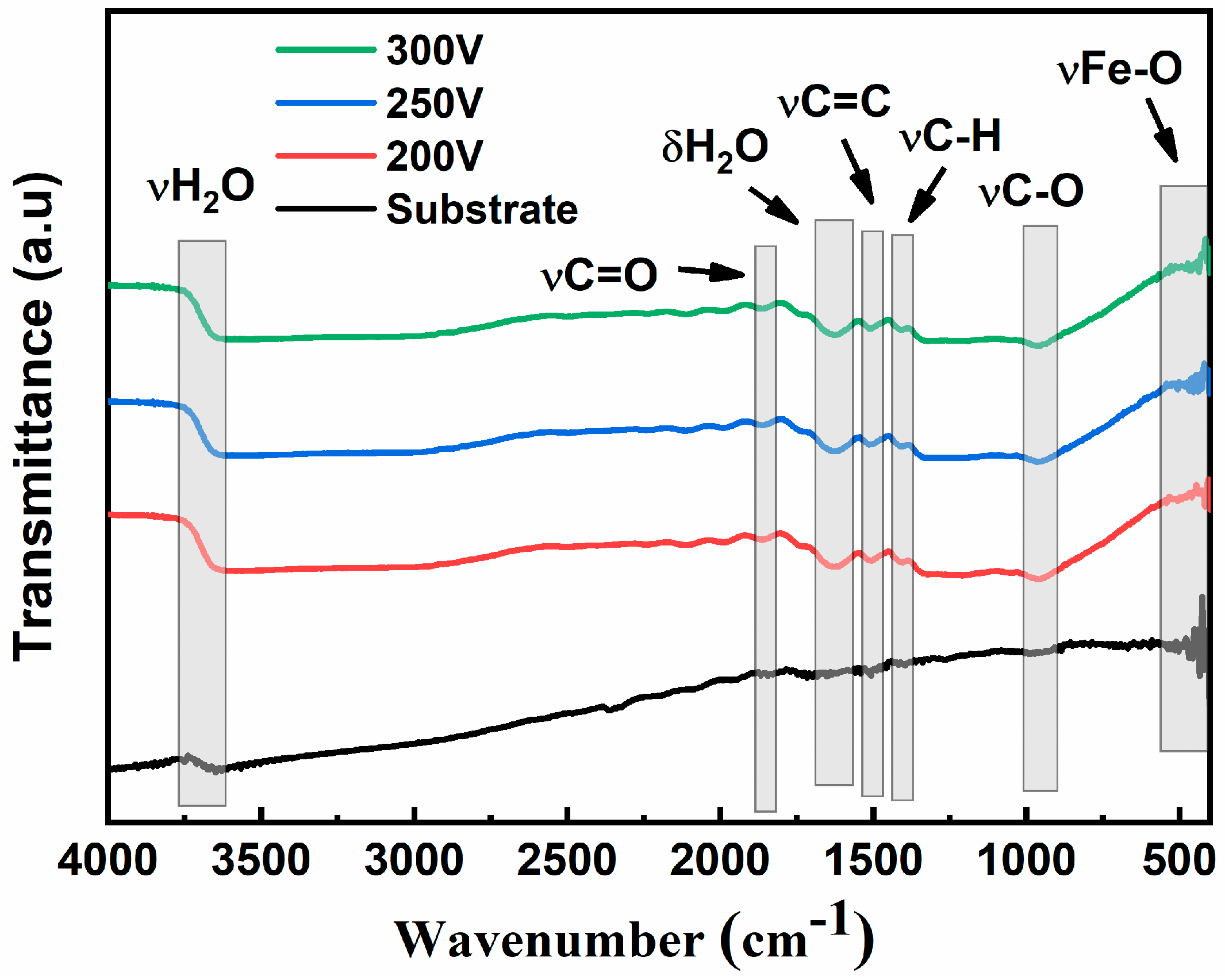
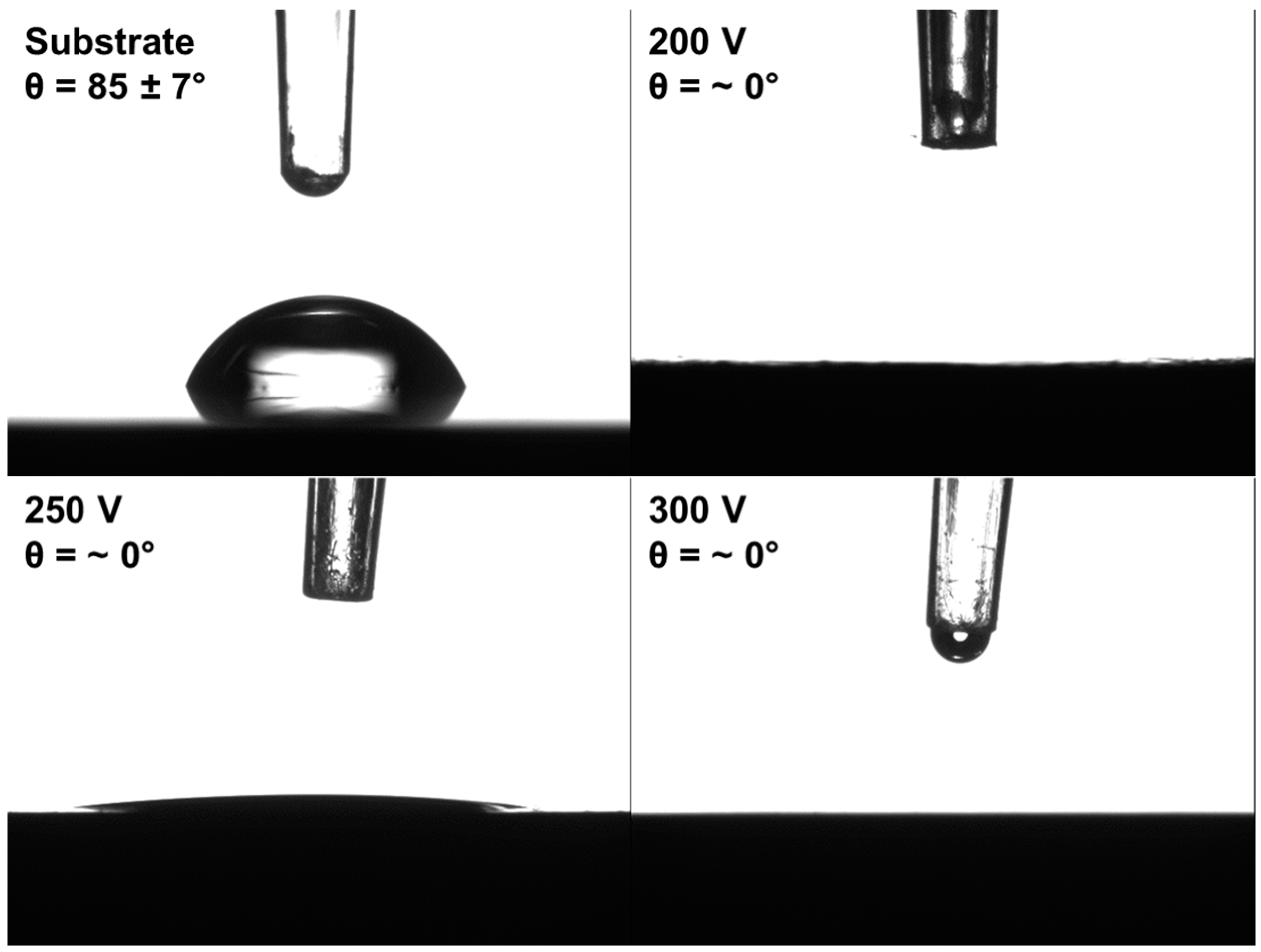
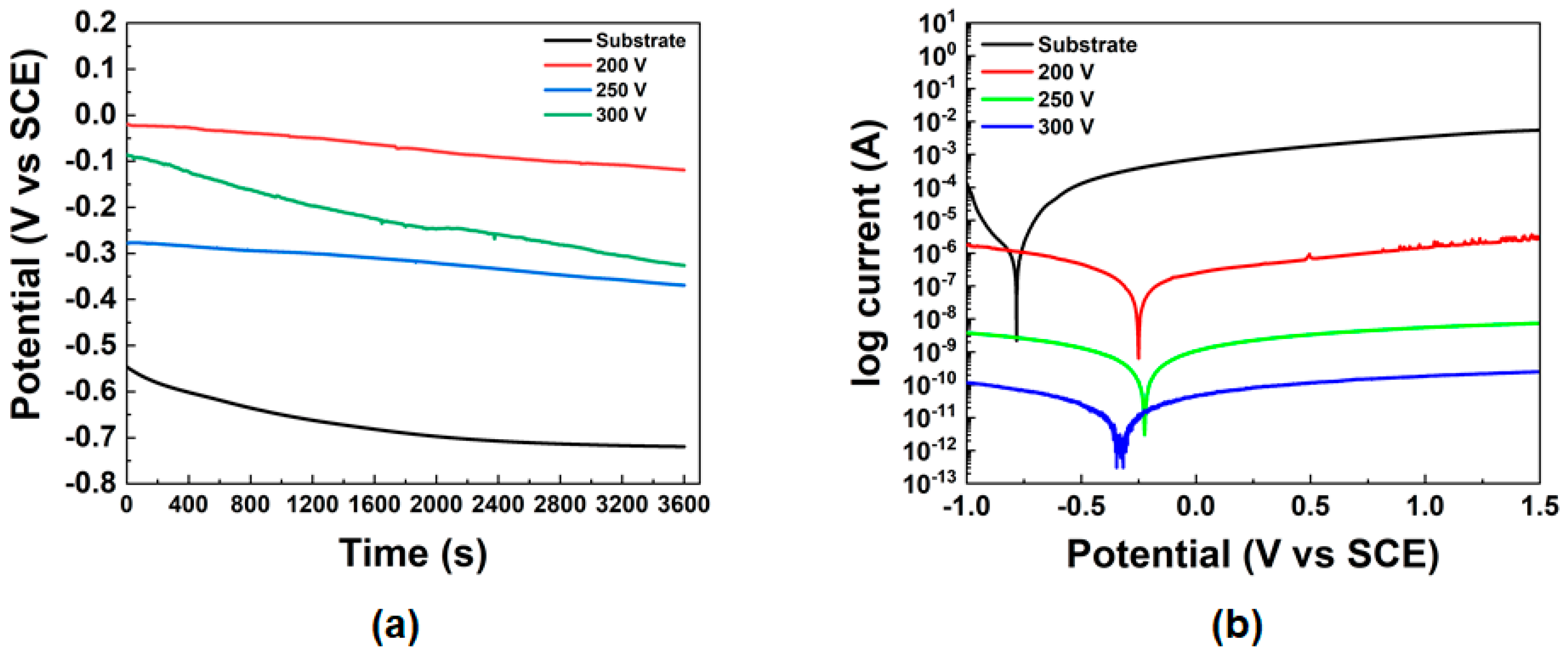
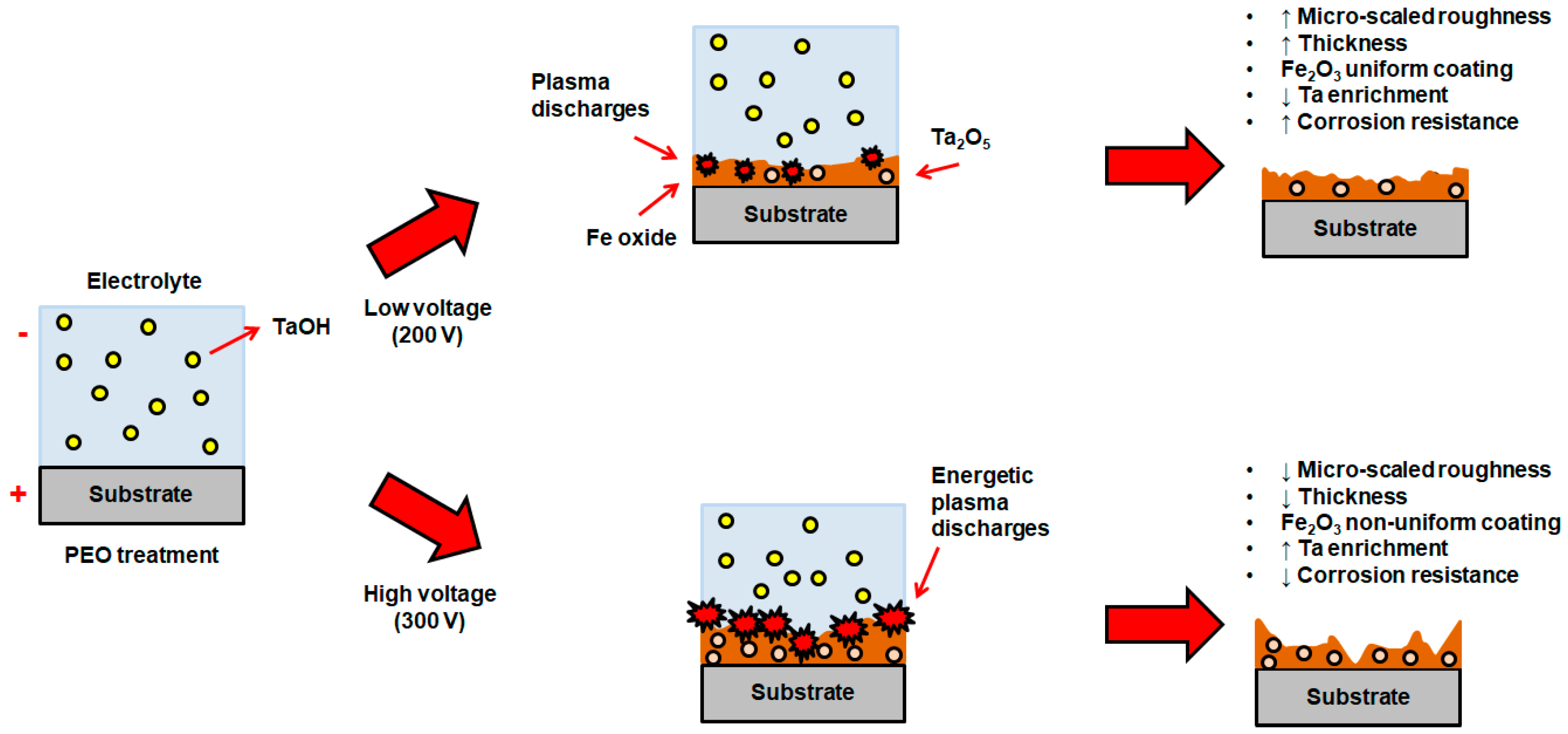
| (%at.) | Fe | C | O | K | Ta |
|---|---|---|---|---|---|
| Substrate | 87.6 | 12.4 | - | - | - |
| 200 V | 37.6 | 13.2 | 46.6 | 0.6 | 2.0 |
| 250 V | 35.2 | 14.2 | 46.8 | 0.8 | 3.0 |
| 300 V | 34.6 | 14.5 | 46.1 | 0.9 | 3.9 |
| Sample | Ra (µm) | Thickness (µm) | Anodic Forming Rate (µm·s−1) | Growth Constant (µm·V−1) |
|---|---|---|---|---|
| Substrate | 1.0 ± 0.1 | - | - | - |
| 200 V | 7.6 ± 0.2 | 75 ± 6 | 0.13 | 0.38 |
| 250 V | 3.4 ± 0.3 | 37 ± 9 | 0.06 | 0.15 |
| 300 V | 2.8 ± 0.5 | 40 ± 10 | 0.07 | 0.13 |
| Sample | Average OCP (V) | Ecorr (V) | icorr (nA·cm−2) | Rp (MΩ·cm2) |
|---|---|---|---|---|
| Substrate | −0.67 | −0.79 | 89.98 | 6.28 |
| 200 V | −0.07 | −0.25 | 3.52 | 6.32 |
| 250 V | −0.32 | −0.23 | ~0.01 | 5.17 |
| 300 V | −0.22 | −0.33 | ~0.01 | 5.16 |
Disclaimer/Publisher’s Note: The statements, opinions and data contained in all publications are solely those of the individual author(s) and contributor(s) and not of MDPI and/or the editor(s). MDPI and/or the editor(s) disclaim responsibility for any injury to people or property resulting from any ideas, methods, instructions or products referred to in the content. |
© 2023 by the authors. Licensee MDPI, Basel, Switzerland. This article is an open access article distributed under the terms and conditions of the Creative Commons Attribution (CC BY) license (https://creativecommons.org/licenses/by/4.0/).
Share and Cite
Marcuz, N.; Ribeiro, R.P.; Rangel, E.C.; da Cruz, N.C.; Correa, D.R.N. The Effect of PEO Treatment in a Ta-Rich Electrolyte on the Surface and Corrosion Properties of Low-Carbon Steel for Potential Use as a Biomedical Material. Metals 2023, 13, 520. https://doi.org/10.3390/met13030520
Marcuz N, Ribeiro RP, Rangel EC, da Cruz NC, Correa DRN. The Effect of PEO Treatment in a Ta-Rich Electrolyte on the Surface and Corrosion Properties of Low-Carbon Steel for Potential Use as a Biomedical Material. Metals. 2023; 13(3):520. https://doi.org/10.3390/met13030520
Chicago/Turabian StyleMarcuz, Nádia, Rafael Parra Ribeiro, Elidiane Cipriano Rangel, Nilson Cristino da Cruz, and Diego Rafael Nespeque Correa. 2023. "The Effect of PEO Treatment in a Ta-Rich Electrolyte on the Surface and Corrosion Properties of Low-Carbon Steel for Potential Use as a Biomedical Material" Metals 13, no. 3: 520. https://doi.org/10.3390/met13030520






